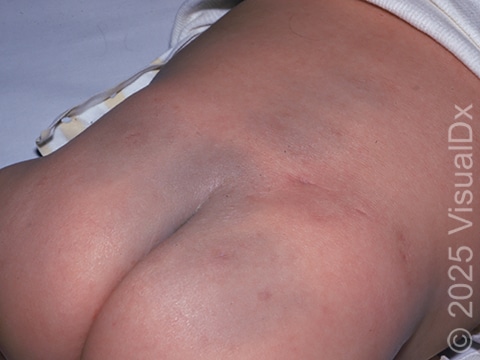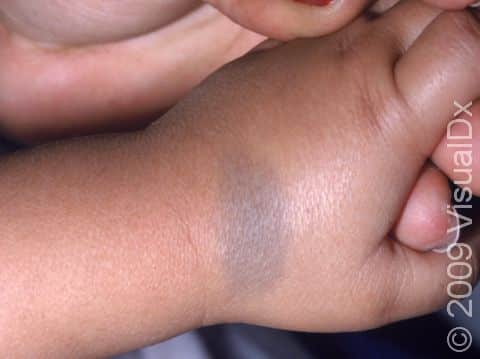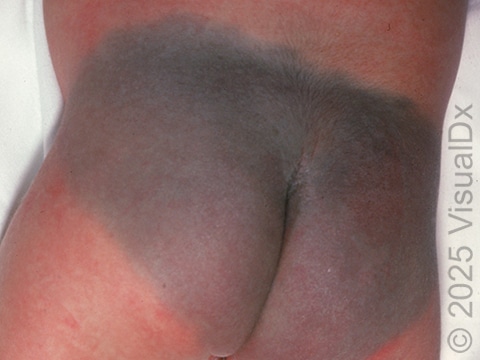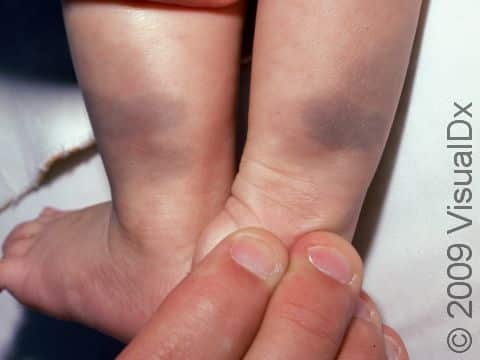Congenital Dermal Melanocytosis (Blue-Gray Spot)
Congenital dermal melanocytosis, also called blue-gray spots and previously known as Mongolian spots, is the most common type of birthmark. It consists of one or more patches (flat, smooth areas of skin larger than a thumbnail) that are usually found on the lower back or buttocks of babies at birth or shortly thereafter. They are sometimes also found on the legs or shoulders of babies. These birthmarks range from deep brown to slate gray or blue-black. They are caused by collections of pigment-producing cells in the skin. The patches often become more pronounced in the first year or two of the baby’s life and then usually fade completely by adulthood.
Who's At Risk?
Blue-gray spots are most common in babies of African or Asian descent, but they can occur in those of any race / ethnicity. Blue-gray spots can occur in any sex, but they are thought to be slightly more common in boys. Full-term infants are more likely to have blue-gray spots than preterm infants.
Signs & Symptoms
Babies may have one or more blue-gray spots, and the patches can range in size from small (one or a few millimeters) to quite large (10 centimeters or larger). They vary in color from gray to blue to black. They are typically round or oval in shape, and their borders can be irregular or indistinct. They are commonly present at birth and become more noticeable around age 1-2 years before starting to fade. Due to their appearance, they can be mistaken for bruises.
Blue-gray spots naturally fade within the first years of life. In very rare cases, they remain into school age and even into adulthood.
Self-Care Guidelines
There is no self-care for blue-gray spots, aside from treating the skin with gentle skin care as you would any other skin of the child.
Treatments
There is no therapy or treatment for blue-gray spots in babies because it is a harmless condition that should go away on its own. However, large or numerous spots that are still present after the baby reaches 1 year may be associated with rare genetic disorders in a very small number of children. If there is a strong family history of genetic disorders along with this condition, the child’s medical professional may decide to send blood to the lab to test for specific genetic diseases, which each have their own specific treatments.
Visit Urgency
There is no need to seek medical care for blue-gray spots. However, if the spot does not fade within the first years of life, see your child’s medical professional. Additionally, especially because this birthmark appears similar to bruises, if you have any questions about whether the spot or spots were present at birth, it is best to seek medical care.
Trusted Links
References
Bolognia J, Schaffer JV, Cerroni L. Dermatology. 4th ed. Philadelphia, PA: Elsevier; 2018.
James WD, Elston D, Treat JR, Rosenbach MA. Andrew’s Diseases of the Skin. 13th ed. Philadelphia, PA: Elsevier; 2019.
Kang S, Amagai M, Bruckner AL, et al. Fitzpatrick’s Dermatology. 9th ed. New York, NY: McGraw-Hill Education; 2019.
Paller A, Mancini A. Paller and Mancini: Hurwitz Clinical Pediatric Dermatology. 6th ed. St. Louis, MO: Elsevier; 2022.
Last modified on July 11th, 2025 at 3:40 pm

Not sure what to look for?
Try our new Rash and Skin Condition Finder



